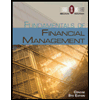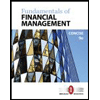
a.
Introduction:
Requirement 1
Total amount of assets invested in A and G in the current year.
b.
Introduction: The return on assets is a financial ratio which states that how profitably a company has employed its assets. In other words, how the company has utilized its assets to generate income.
Requirement 2
The return on assets of the company for the current year of A and G.
c.
Introduction: Expenses are incurred to generate revenues and thus, form an essential part of the income statement.
Requirement 3
The total expenses of the A and G company for the current year.
d.
Introduction: Comparison between similar companies in the same industry is crucial to the assessment of the company’s performance. A company’s financial ratios, when compared with the industry data, can reveal lots of valuable information which the financial statements can not reveal.
Requirement 4
The return of company A and G on assets for the current year is better or worse than the competitor’s average return.
e.
Introduction: Investors greatly rely on financial or accounting ratios along with the financial statements before making decisions for investing in a particular company. The limitations of financial statements can be removed by incorporating the ratios into the analysis and making investment decisions.
Requirement 5
Whether one should invest in G or A company based on return on assets.
Want to see the full answer?
Check out a sample textbook solution
Chapter 1 Solutions
FINANCIAL AND MANAGERIAL ACCOUNTING
- Can you guide me through solving this financial accounting problem using proper techniques?arrow_forwardI need help with this general accounting question using standard accounting techniques.arrow_forwardI am looking for the most effective method for solving this financial accounting problem.arrow_forward
- Please show me the valid approach to solving this financial accounting problem with correct methods.arrow_forwardI need guidance in solving this financial accounting problem using standard procedures.arrow_forwardCan you help me find the accurate solution to this financial accounting problem using valid principles?arrow_forward
- Jazz Corporation owns 50 percent of the Vanderbilt Corporation stock. Vanderbilt distributed a $10,000 dividend to Jazz Corporation. Jazz Corporation's taxable income before the dividend was $100,000. What is the amount of Jazz's dividends received deduction on the dividend it received from Vanderbilt Corporation?arrow_forwardHow can I solve this financial accounting problem using the appropriate financial process?arrow_forwardI am searching for the accurate solution to this general accounting problem with the right approach.arrow_forward
- Please provide the correct answer to this general accounting problem using valid calculations.arrow_forwardBillie Bob purchased a used camera (five-year property) for use in his sole proprietorship in the prior year. The basis of the camera was $2,400. Billie Bob used the camera in his business 60 percent of the time during the first year. During the second year, Billie Bob used the camera 40 percent for business use. Calculate Billie Bob’s depreciation deduction during the second year, assuming the sole proprietorship had a loss during the year. (Billie Bob did not place the asset in service in the last quarter.arrow_forwardAccording to the income tax of Jamaica, a person is a resident if he (a) lives in the country, (b) resides in the country for not more than 183 days, (c) lives in a country 183 days or longer in any one year, or (d) lives in a country for 3 consecutive months in any one year.arrow_forward
 Intermediate Financial Management (MindTap Course...FinanceISBN:9781337395083Author:Eugene F. Brigham, Phillip R. DavesPublisher:Cengage Learning
Intermediate Financial Management (MindTap Course...FinanceISBN:9781337395083Author:Eugene F. Brigham, Phillip R. DavesPublisher:Cengage Learning
 Fundamentals of Financial Management, Concise Edi...FinanceISBN:9781285065137Author:Eugene F. Brigham, Joel F. HoustonPublisher:Cengage Learning
Fundamentals of Financial Management, Concise Edi...FinanceISBN:9781285065137Author:Eugene F. Brigham, Joel F. HoustonPublisher:Cengage Learning Fundamentals of Financial Management, Concise Edi...FinanceISBN:9781305635937Author:Eugene F. Brigham, Joel F. HoustonPublisher:Cengage Learning
Fundamentals of Financial Management, Concise Edi...FinanceISBN:9781305635937Author:Eugene F. Brigham, Joel F. HoustonPublisher:Cengage Learning





